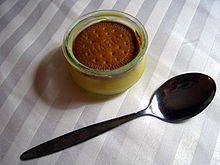Arrowroot
Arrowroot is a
History
Archaeological studies in the
In the early days of carbonless copy paper, arrowroot, because of its fine grain-size, was a widely used ingredient. After an economical way of centrifugally separating wheat flour was devised, arrowroot lost its role in papermaking.[4][5]
Uses
Cultivation in Saint Vincent and the Grenadines
Arrowroot cultivation is now concentrated on farms located north of the Rabacca River, particularly in the Owia area. This is also the area where the population of Carib descent is concentrated. In 1998/99, the industry produced 312,000 lb (142,000 kg) of starch, about 3% of the peak level in the 1960s.
In the past, the St. Vincent arrowroot industry played an important role in the economy of the island, contributing close to 50% of the country's foreign export earnings, and was the principal source of employment and income of the rural people from the 1930s to the 1960s.[6]
The plant is propagated from
The harvesting season extends from October to May. On the larger estates, the
Six factories
Starch extraction process
Arrowroot tubers contain about 23% starch. They are first washed, and then cleaned of the paper-like scale. The scales must be carefully removed before extracting the starch because they impart a disagreeable flavour.[7] After removing the scale, the roots are washed again, drained and finally reduced to a pulp by beating them in mortars or subjecting them to the action of a wheel rasp. The milky liquid thus obtained is passed through a coarse cloth or hair sieve and the pure starch, which is insoluble, is allowed to settle at the bottom. The wet starch is dried in the sun or in a drying house. The result is a powder, the "arrowroot" of commerce, that is quickly packed for market in air-tight cans, packages or cases.
Arrowroot starch has in the past been quite extensively adulterated with
Microscopically the arrow root starch is oval in shape and with hilum at the proximal end.
Culinary

Arrowroot can be consumed in the form of
Arrowroot makes clear, shimmering fruit gels and prevents ice crystals from forming in homemade ice cream. It can also be used as a thickener for acidic foods, such as East Asian sweet and sour sauce. It is used in cooking to produce a clear, thickened sauce, such as a fruit sauce. It will not make the sauce go cloudy, like cornstarch, flour, or other starchy thickening agents would.
The lack of
Arrowroot thickens at a lower temperature than flour or
Shove halfpenny
The English pub game of Shove Halfpenny, involving sliding a coin across a graduated slate board, traditionally uses arrowroot powder as a lubricating medium.
See also
- Polynesian arrowroot
References
 This article incorporates text from a publication now in the public domain: Ward, Artemas (1911). "Arrow-root". The Grocer's Encyclopedia.
This article incorporates text from a publication now in the public domain: Ward, Artemas (1911). "Arrow-root". The Grocer's Encyclopedia.
- ^ Behera, R. S. (2022). "Palua (Arrowroot) – A Wild Edible Tuber In Tribal Hinterlands". SocialDhara.
- S2CID 4429117.
- ^ Piperno, Dolores R. and Pearsall, Deborah M. (1998), The Origins of Agriculture in the Lowland Neotropics, San Diego: Academic Press, p. 115, 199
- S2CID 218686462.
- S2CID 236231260.
- ^ a b c Martin, C. I.; K. A., Leslie; W. B., Charles; P. H., Haynes; E. F., Iton; Egvert, A. Tai (1967). "The arrowroot industry in St. Vincent: A case study of a unique root crop industry in the First Triennial Symposium of Tropical Roots and Tuber Crops, Volume 2, Section V" (PDF). University of the West Indies, St. Augustine, Trinidad. Archived (PDF) from the original on 9 April 2022.
- ^ Rines, George Edwin, ed. (1920). . Encyclopedia Americana.
- PMID 25477633.
- ^ Starch Thickeners at The Cook's Thesaurus
- ^ "Arrowroot Powder Is A Thickening Agent". Heath Recipes. Archived from the original on April 27, 2021.
